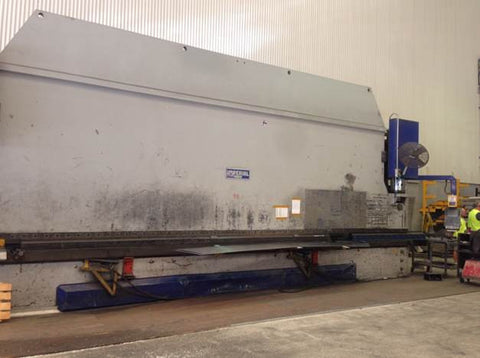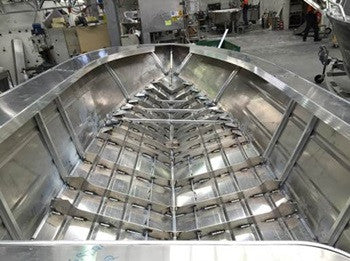This is not a case of which one is better, but which one suits your needs. “Plate” aluminium is anything that comes in a 4mm thickness and above. Aluminium 3mm thick and below is delivered to the boat factories in a roll and 4mm and up comes in sheets. What happens after that does not determine if it is a plate boat or not. Quintrex is the only manufacturer in Australia that has a press big enough to add pressings into 4mm and 5mm plate sheet aluminium.
Pressings add strength to a side or bottom sheet and it is these pressings that are added to all Trident models. Having pressings in a sheet then allows Quintrex to stretch form the sheets into the famous Blade hull. A Trident is a “Plate” boat as it is built from 4mm and 5mm sheet aluminium.

The Quintrex Trident Plate range features 4mm or 5mm bottoms and sides and has the famous Blade hull which combines the traditional Flared bow and Millennium hull. These two features will give you a drier ride in short chop than any other aluminium boat on the market as the finer entry point at the bow cuts through the waves and throws the spray out to the sides.
The Quintrex Yellowfin Plate range is heavier and features 5mm or 6mm bottoms and sides. These sheets are left smooth. A Yellowfin will handle larger swells and adverse conditions extremely well. This type of hull is not as “forgiving” as a Blade hull however will appeal to that traditional plate buyer.So what are the key differences?
So what are the key differences?
Construction Method
The underfloor aspect is completely different on these boats; the Yellowfin consists of 6mm stringers and 5mm ribs whereas the Trident has longitudinal pressings and ribs. (see pictures below). Also, the checker plate floor in the Yellowfin is fully welded to the side sheet of the boat whereas in the Trident they use a ‘’toe jam’’ style of floor. With these differences in mind, and the smooth sheets on the bottom and side of the Yellowfin, the Yellowfin is considered a more traditional plate style boat.
 |
 |
| Trident Hull | Yellowfin Hull |
Handling
These boats handle quite differently to each other. The Trident typically remains flat in turns, is predictable, very stable, dry and easy to drive. The Yellowfin is very smooth in big conditions, tends to lean in to turns given its hull shape and is stable, especially when compared to the older model Yellowfin (this is aided by the extra weight of the thicker bottom sheet and the waterline length having been extended at the transom). For these reasons, the Yellowfin is more suited to regular and heavy offshore use whereas the Trident would lend itself to both offshore and general family usage.
“Should I buy a Yellowfin or a Trident?’’
As a general rule, we believe that somebody who is a previous boat owner, a plate enthusiast and a keen offshore fisherman who wants a task specific product to use in both fair and heavy weather should buy the Yellowfin. The Trident buyer is that person who is probably a bit newer to boating, enjoys fishing offshore and also has the family in mind (the new boater and family will benefit from the predictability, stability, dryness and easy handling and typically wouldn’t head offshore on the poorer days).



